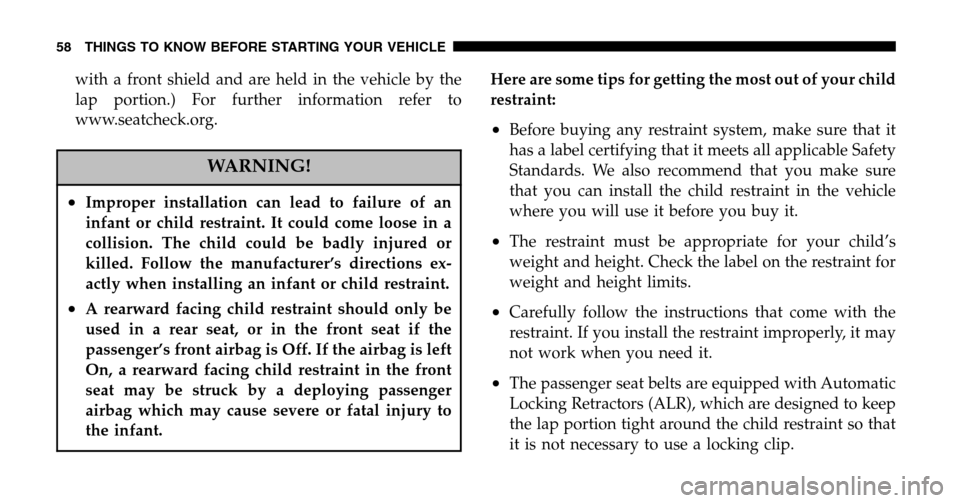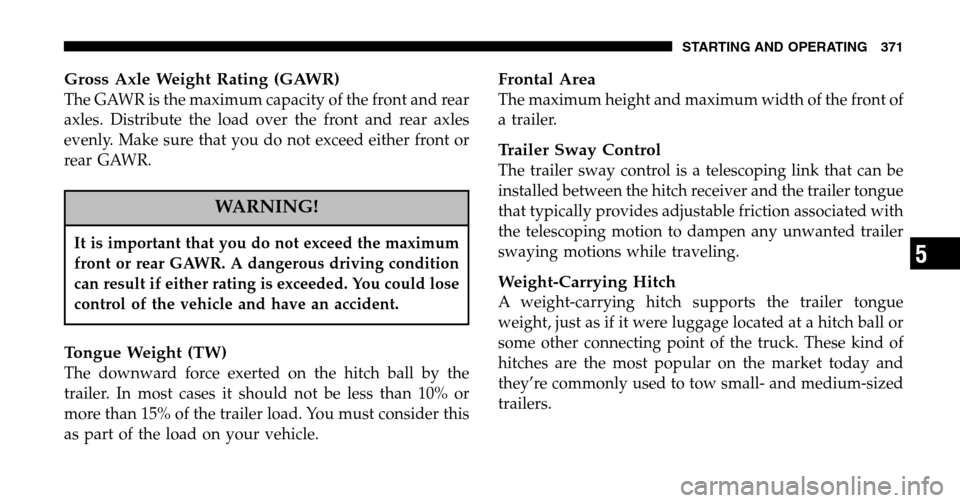Page 58 of 536

with a front shield and are held in the vehicle by the
lap portion.) For further information refer to
www.seatcheck.org.
WARNING!
•Improper installation can lead to failure of an
infant or child restraint. It could come loose in a
collision. The child could be badly injured or
killed. Follow the manufacturer’s directions ex-
actly when installing an infant or child restraint.
•A rearward facing child restraint should only be
used in a rear seat, or in the front seat if the
passenger’s front airbag is Off. If the airbag is left
On, a rearward facing child restraint in the front
seat may be struck by a deploying passenger
airbag which may cause severe or fatal injury to
the infant.
Here are some tips for getting the most out of your child
restraint:
•Before buying any restraint system, make sure that it
has a label certifying that it meets all applicable Safety
Standards. We also recommend that you make sure
that you can install the child restraint in the vehicle
where you will use it before you buy it.
•The restraint must be appropriate for your child’s
weight and height. Check the label on the restraint for
weight and height limits.
•Carefully follow the instructions that come with the
restraint. If you install the restraint improperly, it may
not work when you need it.
•The passenger seat belts are equipped with Automatic
Locking Retractors (ALR), which are designed to keep
the lap portion tight around the child restraint so that
it is not necessary to use a locking clip.
58 THINGS TO KNOW BEFORE STARTING YOUR VEHICLE
Page 96 of 536

Here are some tips for getting the most out of your child
restraint:
•Before buying any restraint system, make sure that it
has a label certifying that it meets all applicable Safety
Standards. We also recommend that you make sure
that you can install the child restraint in the vehicle
where you will use it before you buy it.
•The restraint must be appropriate for your child’s
weight and height. Check the label on the restraint for
weight and height limits.
•Carefully follow the instructions that come with the
restraint. If you install the restraint improperly, it may
not work when you need it.
•The passenger seat belts are equipped with Automatic
Locking Retractors (ALR), which are designed to keep
the lap portion tight around the child restraint so that
it is not necessary to use a locking clip. Pull the belt from the retractor until there is enough to
allow you to pass through the child restraint and slide
the latch plate into the buckle. Then pull on the belt
until it is all removed from the retractor. Allow the belt
to return to the retractor, pulling on the excess web-
bing to tighten the lap portion about the child re-
straint. Refer to the
�Automatic Locking Retractors
(ALR) Mode � earlier in this section.
•In the rear seat, you may have trouble tightening the
lap/shoulder belt on the child restraint because the
buckle or latch plate is too close to the belt path
opening on the restraint. Disconnect the latch plate
from the buckle and twist the short buckle-end belt
several times to shorten it. Insert the latch plate into
the buckle with the release button facing out.
96 THINGS TO KNOW BEFORE STARTING YOUR VEHICLE
Page 150 of 536
The power seat controls are on the outboard side of the
front seat cushions. One switch controls the seat move-
ment. The six-way switch can be moved forward or
backwards to get the most comfortable position. The
same switch can be moved up and down to control seat
height or to change the seat angle by tilting it up or
down.
Power Seat Switch Position
150 UNDERSTANDING THE FEATURES OF YOUR VEHICLE
Page 152 of 536
The power seat controls are on the outboard side of the
front seat cushions. Three switches control the seat move-
ment. The four-way switch in the center can be moved
forward or backwards to get the most comfortable posi-
tion. The same switch can be moved up and down to
control seat height. Change the seat angle by using the
two toggle switches, tilting it up or down.
Up, Down, Forward, and Rearward
152 UNDERSTANDING THE FEATURES OF YOUR VEHICLE
Page 336 of 536
Tire Sizing Chart
EXAMPLE:
Size Designation: P = Passenger car tire size based on U.S. design standards
� ....blank.... �= Passenger car tire based on European design standards
LT = Light Truck tire based on U.S. design standards
T = Temporary Spare tire
31 = Overall Diameter in Inches (in)
215 = Section Width in Millimeters (mm)
65 = Aspect Ratio in Percent (%)
—Ratio of section height to section width of tire.
10.5 = Section Width in Inches (in)
R = Construction Code
— �R�means Radial Construction.
— �D� means Diagonal or Bias Construction.
15 = Rim Diameter in Inches (in)
336 STARTING AND OPERATING
Page 371 of 536

Gross Axle Weight Rating (GAWR)
The GAWR is the maximum capacity of the front and rear
axles. Distribute the load over the front and rear axles
evenly. Make sure that you do not exceed either front or
rear GAWR.
WARNING!
It is important that you do not exceed the maximum
front or rear GAWR. A dangerous driving condition
can result if either rating is exceeded. You could lose
control of the vehicle and have an accident.
Tongue Weight (TW)
The downward force exerted on the hitch ball by the
trailer. In most cases it should not be less than 10% or
more than 15% of the trailer load. You must consider this
as part of the load on your vehicle.
Frontal Area
The maximum height and maximum width of the front of
a trailer.
Trailer Sway Control
The trailer sway control is a telescoping link that can be
installed between the hitch receiver and the trailer tongue
that typically provides adjustable friction associated with
the telescoping motion to dampen any unwanted trailer
swaying motions while traveling.
Weight-Carrying Hitch
A weight-carrying hitch supports the trailer tongue
weight, just as if it were luggage located at a hitch ball or
some other connecting point of the truck. These kind of
hitches are the most popular on the market today and
they’re commonly used to tow small- and medium-sized
trailers.
STARTING AND OPERATING 371
5